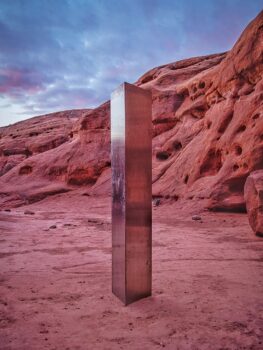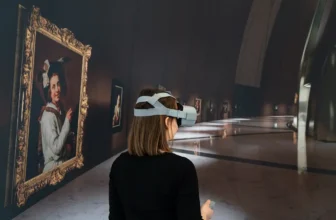Mysterious monoliths appearing worldwide
In the vast expanse of the Utah desert, amid red rock canyons and dry wind, a strange metallic glint caught the eye of a helicopter crew surveying bighorn sheep. What they discovered would ignite a worldwide frenzy, spark countless conspiracy theories, and leave humanity collectively scratching its head: a mysterious monolith.
Towering over ten feet high, perfectly vertical, and gleaming under the desert sun, the monolith stood silently. No tracks led to it. No explanation followed. Like something pulled straight from the imagination of Stanley Kubrick or Arthur C. Clarke, the monolith evoked a blend of awe and unease. And then, just as suddenly as it appeared, it vanished.
But this was only the beginning.
The Utah Monolith: Where the Story Begins
On November 18, 2020, the Utah Department of Public Safety’s Aero Bureau was conducting a routine wildlife count in a remote area of southeastern Utah when they spotted something strange. A shiny, metallic structure stood tucked between red sandstone walls. Resembling the monolith from 2001: A Space Odyssey, it was tall, sleek, and entirely out of place.
The monolith was approximately 10–12 feet high, made of metal panels, and appeared to be deliberately planted in the ground. News of the discovery spread like wildfire once images were posted online. Internet sleuths quickly pinpointed its location using satellite imagery and landmarks, turning it into a modern-day pilgrimage site for adventurers and curiosity-seekers.
Then, almost as abruptly as it had appeared, the monolith vanished on November 27. Witnesses later claimed a group of people had removed it in the night. But the mystery was far from over.
Mystery of Utah’s disappearance of monolith explained
Though the origin remained a mystery, speculation leaned toward a terrestrial artist or film enthusiast, Utah pilot Bret Hutchings quipped it was “some new wave artist or … somebody that was a big ‘2001’ fan”. Experts noted the structure was installed between July and October 2016, remaining hidden for over four years entirely on public federal land.
Once the monolith’s location became public, first hinted at on Instagram then mapped on Reddit, tourists began flocking to the area. Dozens of vehicles scrambled over farmland designed only for 4×4 traffic, causing environmental harm: flattened vegetation, human waste, and strain on local authorities . This “Streisand effect” of revealing the site triggered the very disruption officials wanted to avoid .
Shortly afterward, on the evening of November 27, 2020, four local residents, Andy Lewis, Sylvan Christensen, Homer Manson, and a friend, took action. Witnesses later recounted how the group physically pushed the monolith over, dismantled it using a wheelbarrow, and removed it piece by piece, invoking “Leave No Trace” principles as justification . One onlooker reportedly said, “This is why you don’t leave trash in the desert.”
Following its removal, rumors swirled online: some feared alien intervention, others suspected government ploys. Utah’s Bureau of Land Management confirmed the structure had indeed been taken by private individuals and emphasized that unauthorized installations on federal lands are illegal .
A month later, those four individuals emerged from relative anonymity, Andy Lewis even posted a video showing the intact monolith in his backyard, stating they retrieved it to prevent further environmental damage, as there were reports it might have been destroyed otherwise . Eventually, the group donated the monolith to the Bureau of Land Management, where it now resides under their custody .
The Utah monolith set off a global wave of copycats, over two hundred similar installations appeared around the world in countries from Romania and Wales to the UK’s Isle of Wight . While most thereafter vanished, the original remains a piece of modern art in storage.
In essence, the monolith disappeared not due to aliens or secret programs, but as a deliberate piece of guerrilla art removed by concerned locals aiming to preserve the fragile desert environment it inadvertently endangered.
Is the Monolith Real? Or an Elaborate Hoax?
The Utah monolith was very real, physically speaking. It was no optical illusion or Photoshop trick. Journalists, hikers, and amateur videographers documented its presence and even touched the cool surface of the alien-looking structure.
But the bigger question was: What did it mean?
Theories ranged wildly. Some believed it to be the work of extraterrestrials, left as a signal, warning, or even a joke. Others pointed to secretive art collectives like The Most Famous Artist, who hinted at being involved in the monolith’s creation (though never definitively claimed responsibility for the Utah structure). There were also architectural and design enthusiasts who argued the monolith was a guerrilla installation, an unauthorized work of modern art inspired by sci-fi literature and film.
Regardless of origin, the Utah monolith had a tangible presence. It cast shadows. It was cold to the touch. It was rooted to the Earth, if only temporarily. And most importantly, it was just the beginning.
Monolith Madness: How Many Have Been Found?
After the disappearance of the Utah monolith, something strange happened. Monoliths began to appear everywhere.
As of 2025, over 250 monoliths have been documented worldwide. They emerged in locations as diverse as:
Romania: A metallic monolith appeared on a hill near the Dacian fortress of Petrodava. It vanished days later.
California: Another was spotted atop Pine Mountain in Atascadero.
The Netherlands: A monolith was found in a nature reserve, frost-covered and eerily silent.
Colombia, Canada, Germany, the UK, Spain, and even Antarctica: Each location reported its own monolith, often with subtle differences in size, shape, and construction.
Some monoliths were clearly copycats, constructed with bolts, amateur welds, and visible imperfections. Others were more cryptic, appearing in nearly inaccessible places with no sign of human tampering. A few even had inscriptions or bizarre symbols etched into their surface.
Where Did the Mysterious Monoliths Appear?
Monoliths appeared across every continent (except perhaps for those unconfirmed sightings in the deep oceans). Some of the most notable locations included:
Compton Beach, Isle of Wight (UK)
Karaköy Square in Istanbul, Turkey
The grounds of ancient temples in India
Remote jungles in Brazil
A snowy slope in Poland
Even the grounds of some tech headquarters like SpaceX and Google
The monoliths seemed to favor remote, natural, or symbolically charged locations: deserts, mountains, historic sites, and scenic outlooks. But why? That remains one of the greatest unsolved puzzles.
Are the Monoliths Natural or Man-Made?
Most experts agree: the monoliths are man-made.
They are composed of steel, aluminum, or composite materials, often assembled using common fasteners and tools. This has led many to dismiss the phenomenon as a viral art trend, performance stunt, or copycat movement driven by internet culture.
However, a few installations defy simple explanation.
Some monoliths have appeared in truly remote areas with no signs of transport. Some are fixed in place without obvious means of support or foundation. A few have been constructed with precision and materials difficult to obtain without significant planning and engineering knowledge. These anomalies continue to feed conspiracy theories, particularly those involving aliens or secret societies.
Nonetheless, most monoliths have been identified as artistic expressions. The idea of monoliths as “pop-up art” installations echoes a global desire for mystery and wonder, especially during the bleak, pandemic-stricken days of 2020 and beyond.
Theories Behind the Phenomenon
1. Art and Expression
Perhaps the most grounded explanation is that the monoliths are a decentralized art project. Inspired by the original Utah monolith and Kubrick’s 2001: A Space Odyssey, artists around the world began crafting and installing their own. The monolith became a blank canvas, a symbol open to interpretation.
The Most Famous Artist collective, led by Matty Mo, even claimed responsibility for several monoliths and began selling them on their website for $45,000 each. This commercial angle diluted the myth for some but added a layer of commentary on art, value, and hype.
2. Viral Trend
The monoliths can also be seen as a form of viral expression, a meme brought into the real world. Much like flash mobs or planking, monoliths allowed people to participate in something larger than themselves, with an air of mystery and minimal commitment.
In this sense, the monolith phenomenon mirrors how internet culture shapes real-world events in the digital age.
3. Alien Influence
For the conspiracy-minded, the monoliths represent something far more profound. Are they cosmic breadcrumbs left by extraterrestrials? Are they ancient markers activated by some celestial alignment? Do they hold unknown frequencies or messages?
No scientific evidence supports this theory, but the allure of the unknown ensures it remains popular. The connection to 2001: A Space Odyssey, in which monoliths are tools of alien evolution, only deepens the mythos.
4. Psychological and Cultural Reflection
Some sociologists and psychologists argue that the monoliths reflect a deep collective yearning. In a world shaken by uncertainty, global pandemics, climate change, political turmoil, the sudden appearance of something mysterious, clean, and silent offers a strange kind of comfort. It disrupts our normal expectations and reminds us that mystery still exists.
Monoliths became symbols of the unknown, not to fear, but to marvel at. They reignited the sense of wonder that many felt had been lost in a data-saturated world.
A Mirror Held Up to Humanity
Perhaps the most profound interpretation is that the monoliths are mirrors, not literal ones, but cultural mirrors. They tell us more about ourselves than about their creators.
To artists, they represent creativity and subversion.
To conspiracy theorists, they signal hidden truths.
To the spiritually inclined, they hint at divine messages.
To cynics, they’re just stainless steel distractions.
To dreamers, they’re doorways to the stars.
And maybe that’s the point. The monolith is a mystery, and that mystery becomes what we want or need it to be.
Where Are the Monoliths Now?
Many monoliths have been removed, vandalized, or claimed by authorities. Some remain, quietly watching as the world spins on. Others are privately owned or displayed in galleries. A few have even been preserved as landmarks of modern folklore.
But new ones still appear from time to time, less frequently, perhaps, but no less curiously. In recent years, people have reported monoliths in Siberia, the Australian outback, and even undersea (though those reports remain unverified).
Years from now, when historians look back on the early 2020s, the monoliths will likely stand out as one of the strangest cultural phenomena of the decade. They were born from mystery, fueled by the internet, and shaped by the imaginations of thousands across the globe.
Unlike most viral trends, monoliths didn’t fade because of scandal or saturation, they transformed. From bizarre curiosity to collaborative project. From internet joke to artistic movement. From sci-fi fantasy to psychological mirror.
In the end, the monoliths didn’t come to teach us about aliens or ancient civilizations. They came to remind us of wonder, the kind that makes a hiker pause in a desert, phone in hand, mouth agape, whispering: What is that?
And perhaps that’s enough.
The story of the mysterious monoliths is far from over. Whether they were the work of pranksters, artists, aliens, or all of the above, their sudden emergence across the planet has captivated the imagination of millions.
They ask no questions and offer no answers. They simply exist, silent sentinels in a noisy world, hinting at secrets we may never fully understand. But maybe that’s the beauty of it.
In a world where almost everything can be Googled, explained, and debunked, the monoliths gave us something rare and precious:
A genuine mystery.




